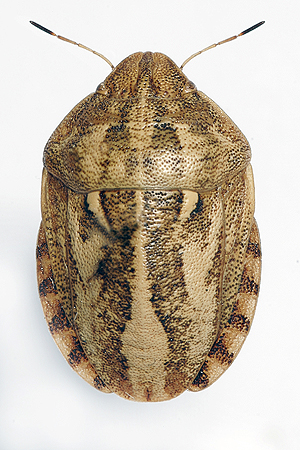Pests
Eurygaster integriceps Puton - Sunn pest, corn bug.
Systematic position.
Class Insecta, order Hemiptera, family Pentatomidae (Scutelleridae), genus Eurygaster.Biological group.
Cereal pests.Morphology and biology.
Bug with varying coloration, more often light brown, 12 mm in length. Body wide-oval. Scutellum big, wide, chitinous, covering wings and whole abdomen, rounded at apex, rarer straight. Imago sexually dimorphous; last segment of female abdomen trapezoid, with distinct longitudinal slit, consisting of 3 pairs of plates; males having one big plate. Average life duration, 28-31 days. Fertility 28-42 eggs, maximum 146-182. Eggs are located in two regular rows with 7 eggs in a row (2-3 batches on the average, maximum 13) on the lower side of leaves, on stalks, on weed vegetation, sometimes on ground lumps. Fertility depends both on abiotic conditions, and on phase of development of grain cereals during feeding. Oviposition lasts 30 to 50 days. Duration of egg development, 6 to 28 days. Development of 5 larval instars passes 20 to 45 days on grain crops, beginning from booting to the end of dough development. Air temperature 20-24 degrees C and precipitation about 25-35 mm per month are optimal for their development. 2nd-3rd-instar larvae have light abdomen and dark head and thorax. 4th-instar larvae have rudiments of forewings, and 5th-instar larvae have rudiments of hind wings.Distribution.
Northern Africa, Bulgaria, Albania, Greece (not numerous everywhere in the Balkans), and also in Turkey, Syria, Iran, Iraq, Israel, Saudi Arabia, Afghanistan and in the north of Pakistan, where sometimes harmful. Distributed in Kazakhstan and Ukraine; in Russia spread in Central Black Earth and Volga Basin Regions, the Northern Caucasus, and also in the Chelyabinsk Region and Bashkortostan.Ecology.
Monovoltine species. Activity of imago starts when plant litter in woods and bushes where the insects winter begins warming up to 12-13 degrees C; flights in field begin at an average daily temperature of 12-14 degrees C. Summer flights usually coincide with dough development of host plant. If insect development is not finished before harvesting, then the larvae and young imagoes finish their feeding under windrows or on fallen ears and grain. After fattening, the bugs fly away and overwinter in plantations of trees; it is more rare that they overwinter among high weed vegetation along ditches, idle lands, and fields.Economic significance.
The major pest of cultivated cereals, especially winter and spring wheat, partly barley and oat. Can damage corn and millet also. Feeds on various cereal grasses, eating also seed pulps on many dicotyledons and even trees occasionally (maple, ash, etc.). Control actions include early spring fertilizing of winter crops by mineral fertilizers with subsequent harrowing, early sowing of crops; grain harvesting in early summer time with subsequent shelling and autumn plowing, selection of resistant varieties; spraying of crops with insecticides against young larvae.Reference citations:
Alekhin V.T. 2002. Sunn pest. Zashchita i karantin rastenii (bibliotechka po zashchite rastenii), 4: 65-90(1-26). (In Russian)Belyaev I.M. 1974. Pests of grain crops. Moscow: Kolos. 284 p. (In Russian)
Kerzhner I.M. 1960. Hemiptera. In: Insect pests of maize in the USSR. Handbook. Moscow & Leningrad. 160-171 p. (In Russian)
Polyakov I.Ya., ed. 1975. Methodical Guidelines: Distribution of the main pests of agricultural crops in the USSR and efficiency of their control. Leningrad: VASKHNIL, VIZR. 66 p. (In Russian)
Puchkov V.G. 1972. Scutelleridae. In: Kryzhanovskii O.L., Dantsig E.M., eds. Insects and mites-pests of agricultural plants. V. 1. Primitive Insects. Leningrad: Nauka. 222-262 p. (In Russian)


